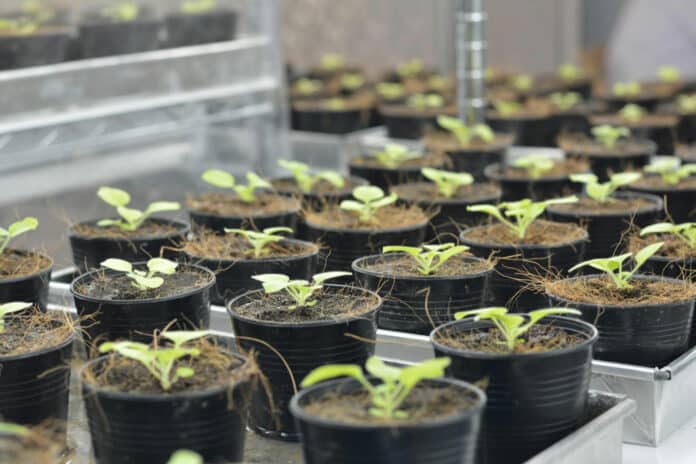Previous work has demonstrated that plants can be used as production platforms for molecules in health, medicine, and agriculture. Production has been exemplified in stable transgenic plants and transient expression strategies.
In particular, species of Nicotiana have been engineered to produce a range of useful molecules, including insect sex pheromones, which are valued for species-specific control of agricultural pests.
Most studies have relied on strong constitutive expression of all pathway genes. However, work in microbes has demonstrated that yields can be improved by controlling and balancing gene expression. By using precision gene engineering techniques, scientists at the Earlham Institute in Norwich have been able to turn tobacco plants into solar-powered factories for moth sex pheromones.
Pheromones are complex chemicals produced and released by an organism to communicate. They allow members of the same species to send signals, which includes letting others know they’re looking for love.
To trap or divert male insects from mating, farmers can place pheromone dispersers amid their crops to mimic the signals of female insects. Chemical techniques can manufacture some of these compounds; however, chemical synthesis is frequently expensive and results in harmful byproducts.
Dr. Nicola Patron, the study’s principal investigator, and director of the Earlham Institute‘s Synthetic Biology Group, employ cutting-edge research to encourage plants to create these priceless natural goods.
DNA’s structural components are subjected to engineering concepts in synthetic biology. DScientists can turn a plant like tobacco into a factory that requires water and sunlight by engineering genetic modules with the instructions to produce new molecules.
Dr. Patron said, “Synthetic biology can allow us to engineer plants to make a lot more of something they already produced, or we can provide the genetic instructions that allow them to build new biological molecules, such as medicines or these pheromones.”
In this work, scientists engineer a species of tobacco, Nicotiana benthamiana, to produce moth sex pheromones. The same plant was previously planned to produce ebola antibodies and even coronavirus-like particles for Covid vaccines.
The Group created artificial DNA sequences in the lab that closely resemble the moth genes and added a few molecular switches to precisely control their expression, which turns the manufacturing process on and off.
The capacity to precisely control pheromone production was a crucial aspect of the new research because continuously forcing plants to produce these chemicals has disadvantages.
Dr. Patron said, “As we increase the efficiency, too much energy is diverted away from normal growth and development. The plants are producing a lot of pheromones, but they’re not able to grow very large, which essentially reduces the capacity of our production line. Our new research provides a way to regulate gene expression with much more subtlety.”
The Group got to work in the lab testing and fine-tuning the regulation of genes in charge of creating a combination of certain chemicals that imitate the sex pheromones of moth species, such as navel orangeworm and cotton bollworm moths.
They demonstrated that copper sulfate could be utilized to precisely regulate gene activity, enabling them to regulate both the time and intensity of gene expression. This is especially crucial because copper sulfate is a cheap, easily accessible chemical that has previously received approval for use in agriculture.
Scientists could even precisely control the creation of various pheromone components, adjusting the resulting concoction to suit particular moth species better.
Dr. Patron said, “We’ve shown we can control the levels of expression of each gene relative to the others. This allows us to control the ratio of products that are made.”
“Getting that recipe right is particularly important for moth pheromones as they’re often a blend of two or three molecules in specific ratios. Our collaborators in Spain are now extracting the plant-made pheromones and testing them in dispensers to see how well they compare to female moths.”
The team hopes their work will pave the way to routinely using plants to produce a wide range of valuable natural products.
Journal Reference:
- Kalyani Kallam, Elena Moreno-Giménez et al. Tunable control of insect pheromone biosynthesis in Nicotiana benthamiana. Plant Biotechnology. DOI: 10.1111/pbi.14048
